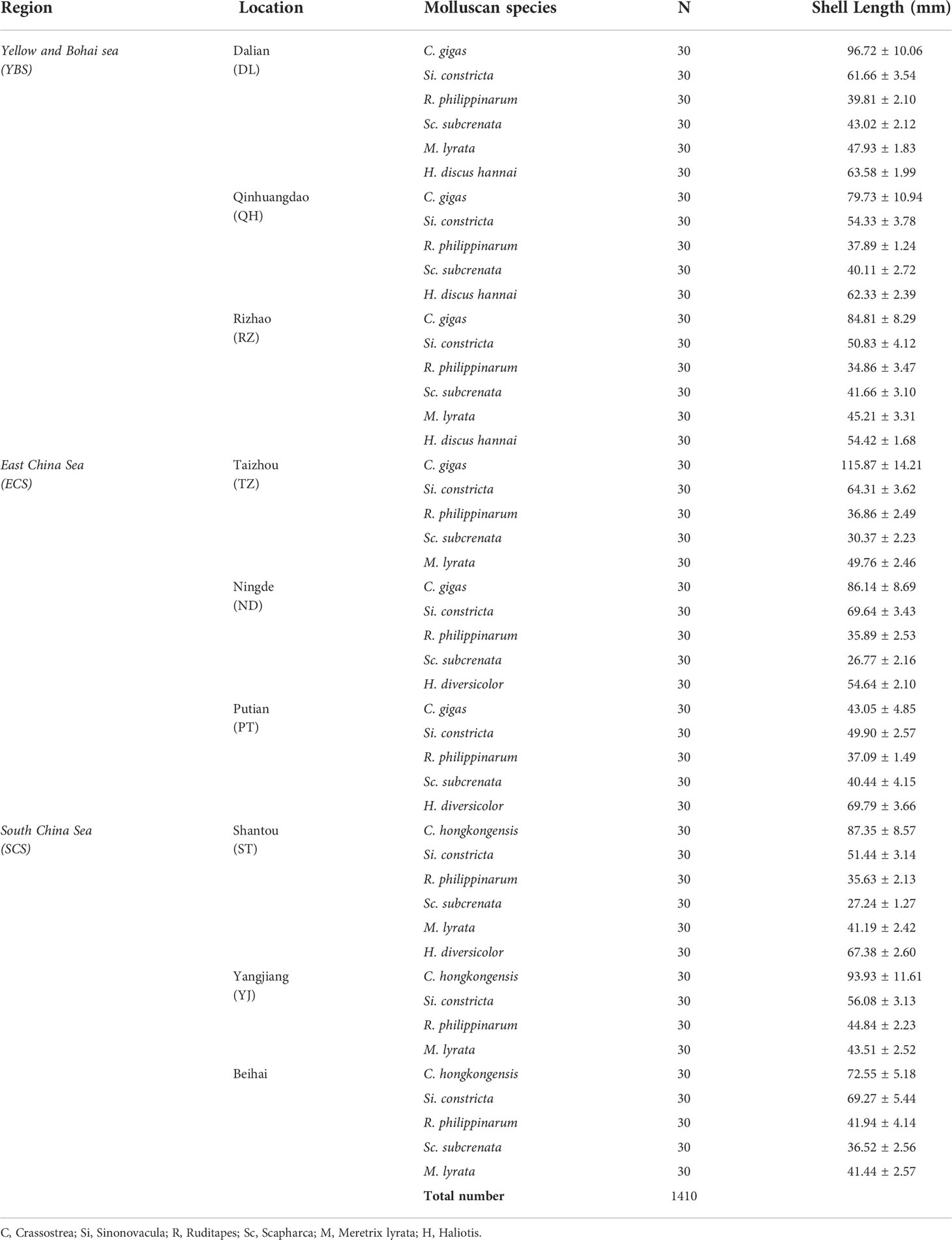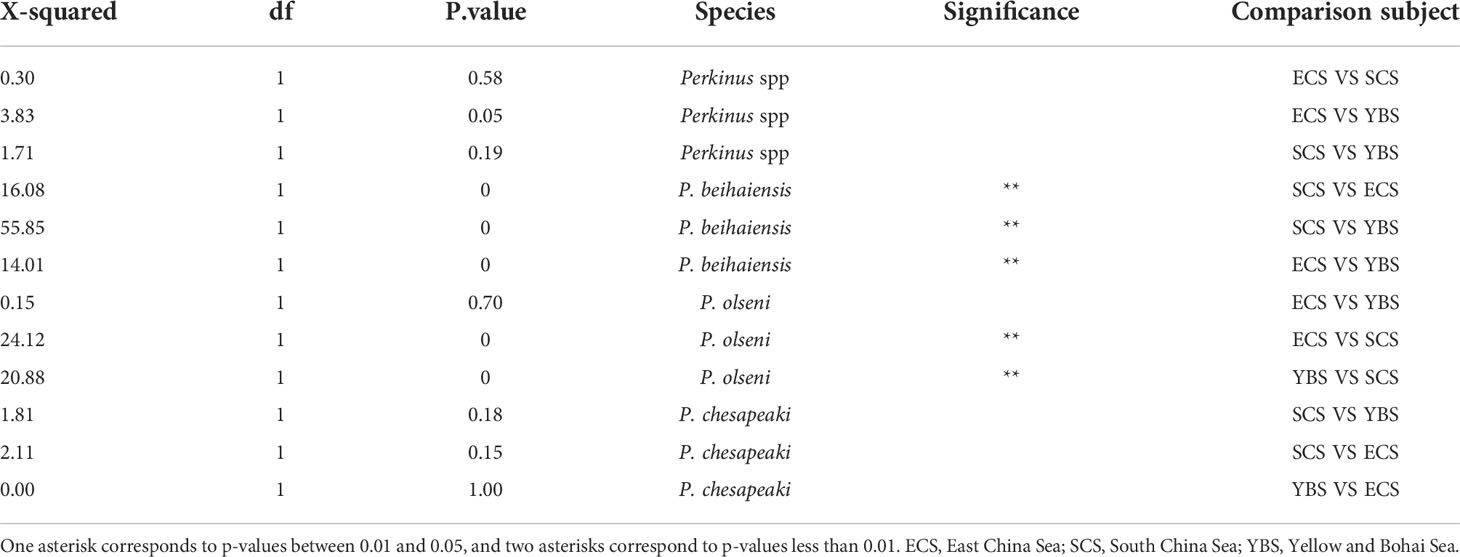- 1Key Laboratory of Aquatic Product Processing, Ministry of Agriculture and Rural Affairs, South China Sea Fisheries Research Institute, Chinese Academy of Fishery Sciences, Guangzhou, China
- 2Key Laboratory of South China Sea Fishery Resources Exploitation and Utilization, Ministry of Agriculture and Rural Affairs, Ministry of Agriculture and Rural Affairs, South China Sea Fisheries Research Institute, Chinese Academy of Fishery Sciences, Guangzhou, China
- 3School of Life Science, Huizhou University, Huizhou, China
- 4Shenzhen Fisheries Development Research Center, Shenzhen, China
Perkinsus species, which are parasitic pathogens of mollusks, have been transmitted and dispersed to various molluscan species along the coastal waters of many countries. However, few studies have addressed the diversity and distribution of Perkinsus spp. along the coast of China. Here we used conventional PCR amplification and sequencing techniques, combined with a qPCR assay as a confirmatory test, to evaluate the prevalence of Perkinsus species in molluscan species among different sea regions of China. Three Perkinsus species—P. olseni, P. beihaiensis, and P. chesapeaki—were detected, with P. chesapeaki reported for the first time along the Chinese coast. Seven of eight molluscan species carried Perkinsus species, including Crassostrea gigas, C. hongkongensis, Sinonovacula constricta, Ruditapes philippinarum, Scapharca subcrenata, Meretrix lyrate, and Haliotis diversicolor. Perkinsus olseni was prominent in the Yellow and Bohai Sea and East China Sea, while P. beihaiensis was prominent in the South China Sea. Most of the molluscan species carried Perkinsus spp. with the medium or low levels of PCR-prevalence (<30%). The three Perkinsus species possess high levels of internal transcriber spacer haplotypes, some of which are shared among many countries. The much higher PCR-prevalence of Perkinsus spp. in the clam Ruditapes philippinarum and the oyster Crassostrea hongkongensis suggests that Perkinsus species may be transmitted and dispersed to other mollusks through the transportation of Perkinsus-carried R. philippinarum and C. hongkongensis. Perkinsus carrying tended to be generally linked with a broader geographic range, lower prevalence, more diversified molluscan hosts, and more diversified Perkinsus haplotypes.
Introduction
Mollusks are popular seafoods and account for over 80% of marine aquaculture production, making them the most cultured species in global mariculture in recent decades (Yang, 2016; FAO, 2020). China has the largest marine molluscan aquaculture areas, the largest number of cultivated molluscan species, and the highest molluscan production in the world (Bureau of Fisheries of the China’s Ministry of Agriculture and Rural Affairs, 2020a; FAO, 2020). However, molluscan diseases occur frequently in China, and the molluscan industry has sustained severe economic losses in recent years. In 2019, the economic loss of mollusks owing to disease reached 9.51 billion RMB, accounting for 23.3% of the total economic loss of aquaculture (Bureau of Fisheries of the China’s Ministry of Agriculture and Rural Affairs, 2020b).
As potentially devastating pathogens, the protozoan parasites of the genus Perkinsus have caused large-scale mortality in many molluscan species (e.g., oysters, abalones, clams, scallops, pearl oysters, cockles, mussels) worldwide, resulting in large economic losses (Villalba et al., 2004; Choi and Park, 2010; Dungan and Reece, 2020). Thereinto, P. marinus and P. olseni, have been described as internationally reportable or notifiable pathogens for mollusks on the list of the World Organization for Animal Health (OIE, https://www.oie.int/en/produit/manual-of-diagnostic-tests-for-aquatic-animals-2021/). Increasing numbers of molluscan species have been found to be infected by Perkinsus spp., including some wild molluscan species (Brousseau et al., 1998; Cui et al., 2018; Dungan and Reece, 2020), which suggests that Perkinsus spp. are widely distributed and have been transmitted to most molluscan species. Perkinsus spp. tend to be more geographically widespread and diverse, and an increasing number of countries and regions have detected infection by several species of Perkinsus (Neto et al., 2016; Pagenkopp Lohan et al., 2016; Shamal et al., 2018).
As a result of various ecological, epidemiological, and evolutionary determinants, parasite species biodiversity exhibits a range of geographic patterns (Poulin et al., 2011; Morand, 2015). Moreover, host traits and parasite specificity may shape parasite biogeography (Krasnov et al., 2008; Poulin et al., 2011). Generally, parasite species richness is assumed to be high in the tropics, matching the high host diversity there (Torchin et al., 2015). China has 18,000 km of continental coastline in the western Pacific that crosses approximately 50 degrees of latitude from the south to north and includes three distinctly different sea regions (the Yellow and Bohai Sea, East China Sea, and South China Sea). China has more than 800 molluscan species, approximately 20 of which had been farmed commercially on a large scale along the shoreline. Whether the distribution and diversity of Perkinsus spp. have been affected by latitudinal gradients and host traits is relatively unknown and has yet to be monitored in the sea regions of China.
In this study, we used conventional PCR amplification and sequencing techniques, combined with a qPCR assay as a confirmatory test, to evaluate the prevalence of Perkinsus spp. in molluscan species among different sea regions of China. The internal transcriber spacer (ITS) sequences obtained here were combined with related Perkinsus spp. ITS sequences in NCBI Genbank and used to analyze the global haplotypes and their distribution in China. Our study mainly focuses on three areas: 1) the species diversity of Perkinsus spp. in different sea regions of China; 2) the geographical distribution of Perkinsus spp. in China; and 3) the diversity and distribution of Perkinsus spp. haplotypes. Our study provides a comprehensive assessment of Perkinsus spp. distribution and evaluates the ranges of molluscan species carried Perkinsus spp., thus providing a solid foundation for the prevention and control of perkinsosis in mollusks in China.
Materials and methods
Sampling
From August to September of 2017, as many molluscan species as possible were collected from various intertidal and subtidal habitats, or purchased from local farmers who collected them along local coastal waters, at multiple locations in three contiguous geographical regions of China, namely the Yellow and Bohai Sea (herein YBS), East China Sea (ECS), and South China Sea (SCS). Following the measurement of shell length, the gill, mantle, and digestive gland tissues of each live molluscan specimen were dissected using forceps, excised, and preserved in 95% (v/v) ethanol for further molecular assays. To avoid extracting DNA from the filtered particles attached onto the gill surface, gill tissue from each sample was completely washed via sterile Pasteur pipette at least three times with 0.2 M phosphate-buffered saline (PBS, pH 7.4) before being preserved in 95% (v/v) ethanol. For the convenience of Perkinsus spp. carrying comparisons, we selected as target samples the molluscan species that most frequently occurred at multiple locations of each typical sea region. Detailed information on molluscan sampling is shown in Table 1. Briefly, three locations at each sea region were screened as target locations, namely Dalian (DL), Qinhuangdao (QH), and Rizhao (RZ) located in the YBS; Taizhou (TZ), Ningde (ND), and Putian (PT) in the ECS; and Shantou (ST), Yangjiang (YJ), and Beihai (BH) in the SCS (Figure 1). To detect the carrying of Perkinsus species, a total of 1,410 individuals representing eight molluscan species were used, including Crassostrea gigas, C. hongkongensis, Sinonovacula constricta, Ruditapes philippinarum, Scapharca subcrenata, Meretrix lyrate, Haliotis discus hannai, and H. diversicolor. At each location, 30 individuals of each molluscan species were randomly sampled (Table 1).
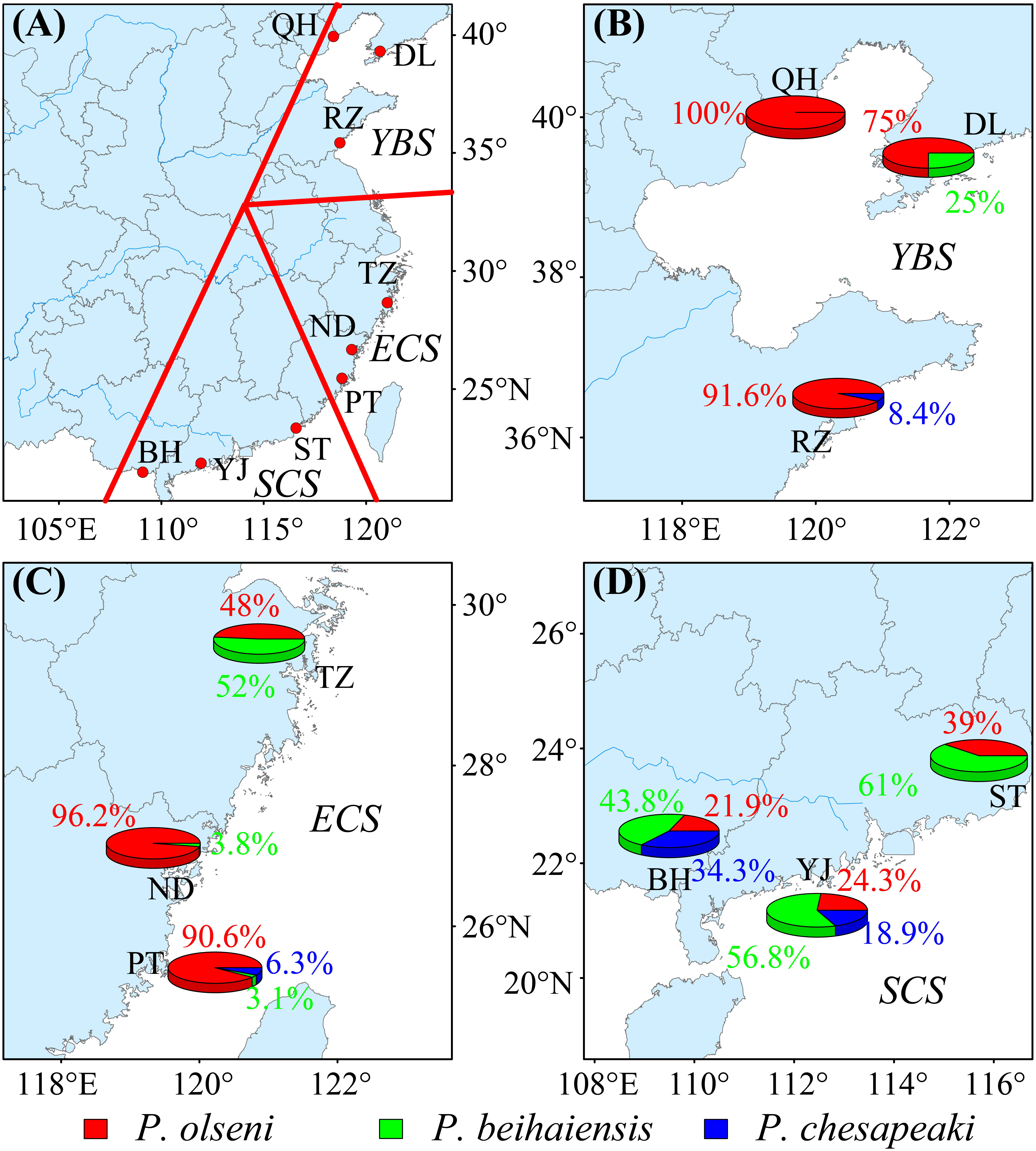
Figure 1 Map of sampling locations along the coast of China (A) and Perkinsus species carrying rate in molluscan species at different locations in the Yellow and Bohai Sea (YBS) (B), East China Sea (ECS) (C), and South China Sea (SCS) (D). DL, Dalian; QH, Qinghuangdao; RZ, Rizhao; TZ, Taizhou; ND, Ningde; PT, Putian; ST, Shantou; YJ, Yangjang; BH, Beihai.
DNA extraction, PCR amplification, and sequencing
Approximately 100 mg of gill, mantle and digestive gland tissue was cut individually, and mixed in a 1.5-ml Eppendorf tube. The three tissues of each sample were then homogenized in 0.1 M sodium phosphate buffer. The resulting tissue homogenate was subjected to DNA extraction procedures using MicroElute Genomic DNA Kit (Omega, USA) according to manufacturer’s instructions.
The genus-specific primer pairs, PerkITS85 (5′CCGCTTTGTTTGGMTCCC3′) and PerkITS750 (5′ACATCAGGCCTTCTAATGATG3′) (Casas et al., 2002), were used to amplify an approximately 700-bp fragment of the ITS region of Perkinsus spp. PCR was performed in a 25-μL volume consisting of 12.5 µL of 2×PCR Mix (Dongsheng Biotech, Guangzhou, China), 1 µL each of forward and reverse primers (10 µM), 1 µL of template DNA, and 9.5 µL of ultrapure water. A positive control (1,000 copies of P. beihaiensis-pMD 18T recombinant plasmid DNA) and a negative control (nuclease-free water) were included in each PCR run. The amplification was performed with an initial denaturation at 95°C for 3 min, followed by 35 cycles at 95°C for 30 s, 60°C for 1 min, and 72°C for 1 min, with a final elongation at 72°C for 7 min. The PCR results were confirmed on 1% agarose gel stained with SYBR green. Samples were considered positive PCR products if a product of ~700 bp was detected, the positive control showed the same band size, and the negative and nontemplate controls showed no bands. Positive PCR products were sequenced in both directions using amplification primers and ABI Big Dye Terminator Chemistry on an ABI 3730XL automatic DNA sequencer (Applied Biosystems, USA).
The forward and reverse sequences from the same sample were assembled to one consensus sequence using SeqMan 4.0 (DNAStar, Madison, WI, USA) and manually edited to ensure that all bases within the consensus sequence were identical in both the forward and reverse sequences. The species of Perkinsus present in each molluscan sample were determined by comparing the target sequences with those in GenBank. When the target sequence of the species showed 99.5%–100% identity to that of Perkinsus spp. deposited in GenBank, the identified species was regarded as Perkinsus spp. (Cui et al., 2018).
qPCR assay for confirmation
According to the sequencing results, 349 positive samples were identified as three Perkinsus species, namely P. olseni, P. beihaiensis, and P. chesapeaki. A confirmatory qPCR test was performed among the 349 positive samples to minimize the number of false positive samples. For each sample, Perkinsus-specific qPCR assays were run for P. olseni (POF: 5′-GAG TGTCTC TGGTTGCTCGCA A-3′; PO-R: 5′-ACA TCAGGC CTT CTA ATG ATG-3′) (Cui et al., 2018), P. beihaiensis (Q2-F: 5′-TCGATGAAGGACGCAACGAA-3′; Q2-R: 5′-CTCATTTCTGCGGGGCTACA-3′) (Wu et al., 2019), and P. chesapeaki (forward primer 5′-AAG TCG AAT TGG AGG CGT GGT GAC-3′; reverse primer 5′-ATT GTG TAA CCA CCC CAG GC-3′) (Marquis et al., 2020). The sets of primers for P. olseni and P. beihaiensis target the ITS region, and the set of primers for P. chesapeaki targets the NTS (non-transcribed spacer) region. DNA standards for qPCR were prepared from qPCR-positive samples that were cloned and serially diluted 10-fold over six orders of magnitude (2.6×107 to 2.6×102 copies/μL). The qPCR was carried out in a 10 μL reaction, comprising 5 μL TB Green™ Premix (TaKaRa, Kusatsu, Japan), 0.5 μL of each primer (10 μM), 1 μL of extracted DNA and 3 μL of nuclease-free water. Reactions were conducted in triplicate on an Eco™ Real-Time PCR System (Illumina, San Diego, CA, USA) using the Eco System Software with the following temperature program: 95°C for 30 s; 40 cycles of 95°C for 5 s and 60°C for 40 s. In all reactions P. olseni, P. beihaiensis, or P. chesapeaki DNA was used as a positive control, and DNase-free water as the non-template control. A sample was considered positive if the qPCR threshold cycle (CT) value of the product rose above zero before the 30th cycle, at the same time, the qPCR CT value of the negative and non-template controls were zero before the 30th cycle.
According to the confirmatory qPCR test results, of the 349 conventional PCR-positive samples, 306 samples tested positive and 43 samples negative. Therefore, 306 molluscan samples that tested positive in both the conventional PCR test and qPCR test were deemed carrying the Perkinsus spp.
Diagnosis of Perkinsus spp. carrying
The PCR-prevalence of Perkinsus spp. was considered to be the percentage of infected mollusks in the total samples. The PCR-prevalence of Perkinsus spp. was divided into four PCR-prevalence grades: 1) no carrying (PCR-prevalence 0%); 2) low (PCR-prevalence greater than 0 and less than or equal to 20%); 3) medium (PCR-prevalence greater than 20% and less than or equal to 50%); and 4) high (PCR-prevalence greater than 50%). The carrying rate of Perkinsus spp. was defined as the ratio between the number of mollusks carrying the specific Perkinsus sp. and the total number of Perkinsus-carried mollusks in the specific sampling location.
Haplotype analysis
To generate global haplotype networks for each species, all sequences of the specific Perkinsus species in the present study were combined with the same Perkinsus species sequences obtained from GenBank. Only those sequences that definitely annotated the source country information in GenBank were used. For each Perkinsus sp., sequences were aligned using Clustal X 1.83 (Thompson et al., 1997) with the default parameters. The resulting alignments were manually edited using the program BioEdit (Hall, 1999). To obtain the equal lengths of all aligned sequences, alignments were trimmed at both ends. In the resulting alignments, the sequences that included ambiguous bases (e.g., degenerate bases) were deleted to avoid an inflation of haplotypes.
Haplotype networks were preliminarily generated with these alignments using the haplotypes package (Aktas, 2020) in the R software environment. For each Perkinsus sp. preliminary haplotype network, if single haplotypes included multiple sequences from the same country, then only the unique sequences were retained in that alignment. The sequences that had unique haplotypes in China but no sequence records in GenBank were submitted to NCBI and registered in GenBank (accession nos. MT908881–MT908909). Following these sequence screenings, three alignments were ultimately used to create the global networks, including a 481-bp alignment containing 171 sequences for P. beihaiensis, a 497-bp alignment containing 378 sequences for P. olseni, and a 492-bp alignment containing 86 sequences for P. chesapeaki.
Haplotype networks were generated with those screened alignments using the haplotypes package (Aktas, 2020) with its default parameters in the R software environment. Each haplotype corresponded to the country from which it was sampled in the haplotype network analyses. The haplotype networks that were generated were exported using the export package (Wenseleers and Vanderaa, 2018) to Microsoft PowerPoint and slightly revised to a final graph version.
Statistical analysis
Statistical analyses were performed in the R software environment. Pairwise comparisons of Perkinsus spp. PCR-prevalence among different regions and molluscan species were conducted using the Chi-square test in the stats package (R Core Team, 2020) with the default parameters. Statistical significance was set at P < 0.05. Except for the haplotype networks graphs, all graphs were drawn using the ggplot2 package (Wickham, 2016) in R.
Results
Species diversity of Perkinsus spp.
Three Perkinsus species—P. olseni, P. beihaiensis, and P. chesapeaki—were detected in molluscan species along the coast of China’s waters (Figure 1). The carrying rates of P. olseni ranged from 75% to 100% at the sites located in the YBS and from 48% to 96.2% in the ECS sites (Figure 1), which were clearly higher than those in the SCS (21.9%–39%). The carrying rates of P. beihaiensis ranged from 43.8% to 61% at the sites located in the SCS, which were higher than those in the ECS (3.1%–52%) and YBS (0%–25%) (Figure 1). The carrying rates of P. chesapeaki were far less than those of P. olseni and P. beihaiensis, and P. chesapeaki was mainly carried by the molluscan species located in the SCS (Figure 1).
The PCR-prevalence of P. olseni was highest in R. philippinarum (51.8%) and clearly higher than that in other molluscan species (Figure 2). The highest PCR-prevalence of P. beihaiensis occurred in C. hongkongensis and was also evidently higher than that in other molluscan species (Figure 2). The PCR-prevalence of P. chesapeaki was at the low carrying grade in molluscan species, and the highest PCR-prevalence was in S. subcrenata (only 4.2%).
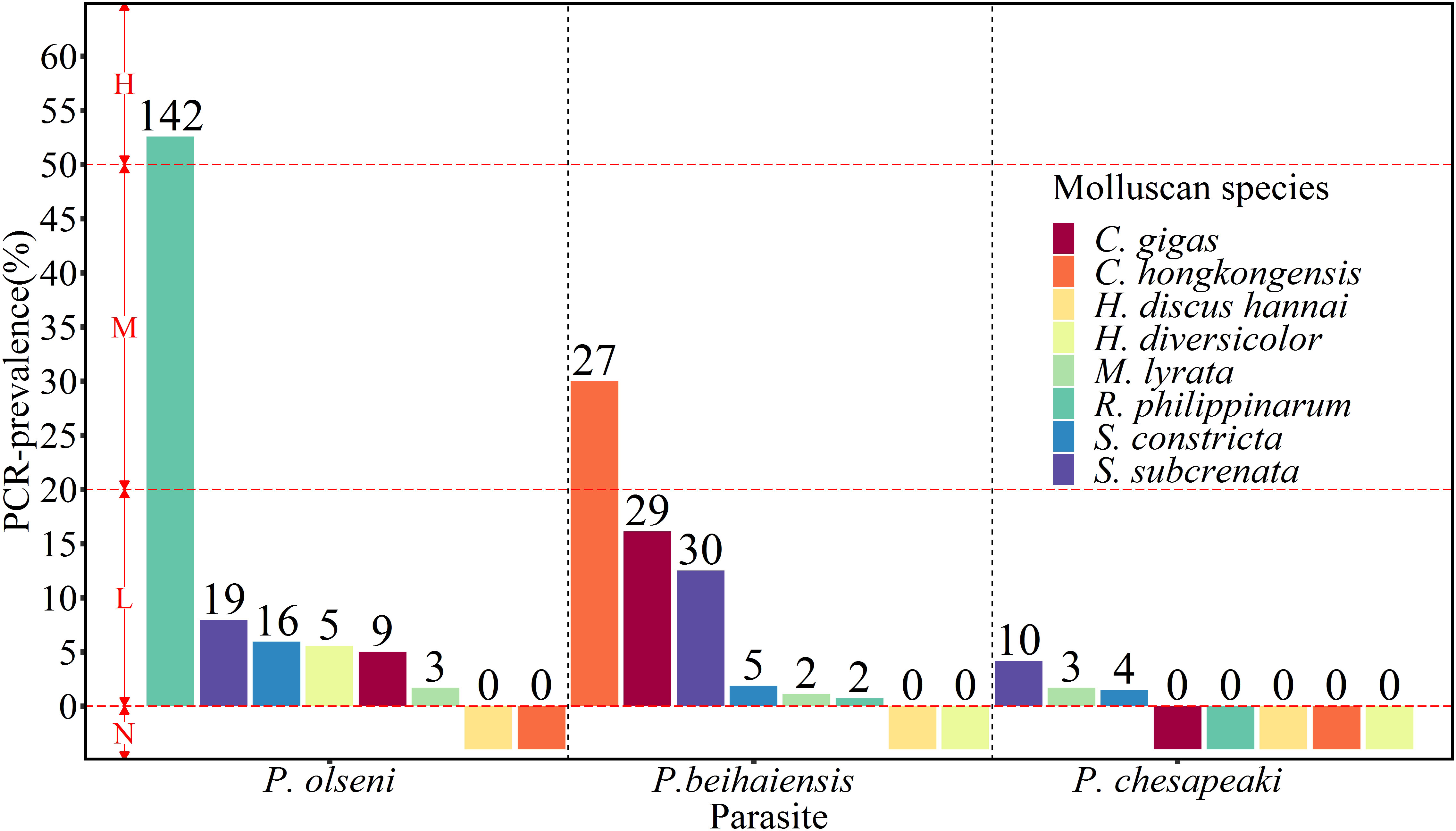
Figure 2 Perkinsus species diversity in different molluscan species in waters along the coast of China. Numbers above the bars indicate the total number of Perkinsus-carried individuals for each molluscan species. H: high PCR-prevalence grade; M: medium PCR-prevalence grade; L: low PCR-prevalence grade.
Seven of eight molluscan species carried Perkinsus species, including Crassostrea gigas, C. hongkongensis, Sinonovacula constricta, Ruditapes philippinarum, Scapharca subcrenata, Meretrix lyrate, and Haliotis diversicolor (Figure 3).
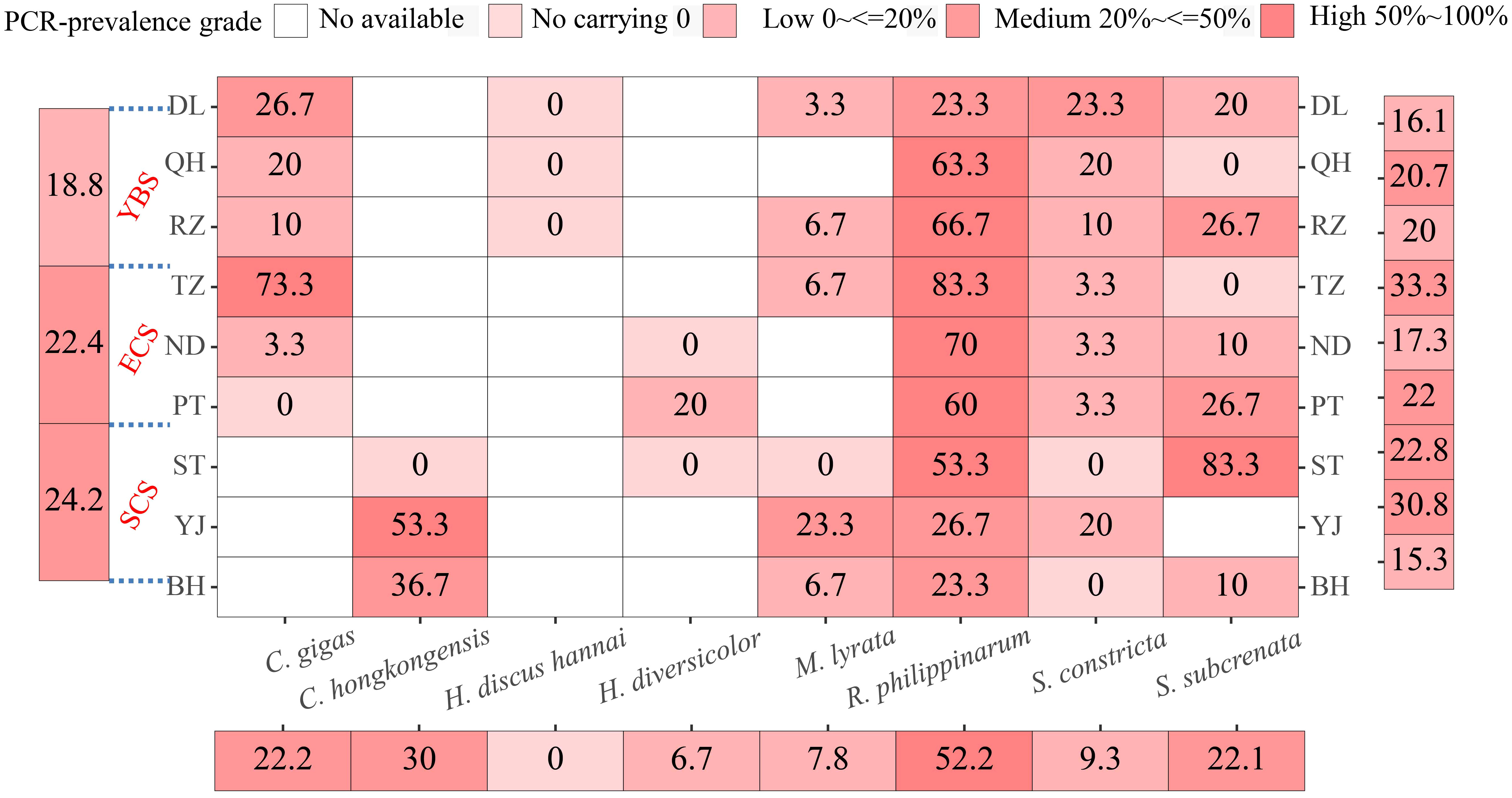
Figure 3 Heat plot revealing PCR-prevalence of Perkinsus species in different molluscan species, locations, and sea regions along the coast of China.
Geographical distribution of Perkinsus spp.
The PCR-prevalence of Perkinsus spp. at most locations were at the medium carrying grade and did not differ significantly (Figure 3). The PCR-prevalence of Perkinsus spp. ranged from 15.3% (in BH) to 33.3% (in TZ). The PCR-prevalence of Perkinsus spp. was higher in the SCS (24.2%) than in the ECS (22.4%) and YBS (18.8%) (Figure 3; Table 2).
Diversity and distribution of three Perkinsus spp. haplotypes
A total of 43 haplotypes from four countries were detected in the P. beihaiensis global network (Figure 4). In this network, six shared haplotypes were found, including four haplotypes (H1, H2, H4, H6) shared by three countries and two haplotypes (H3, H5) shared by two countries (Figure 4). Five of six shared haplotypes were found in China. Eighty-six percent of haplotypes (37 of 43) was found in China, with 32 of the 37 haplotypes having been recovered only from China (Figure 4).
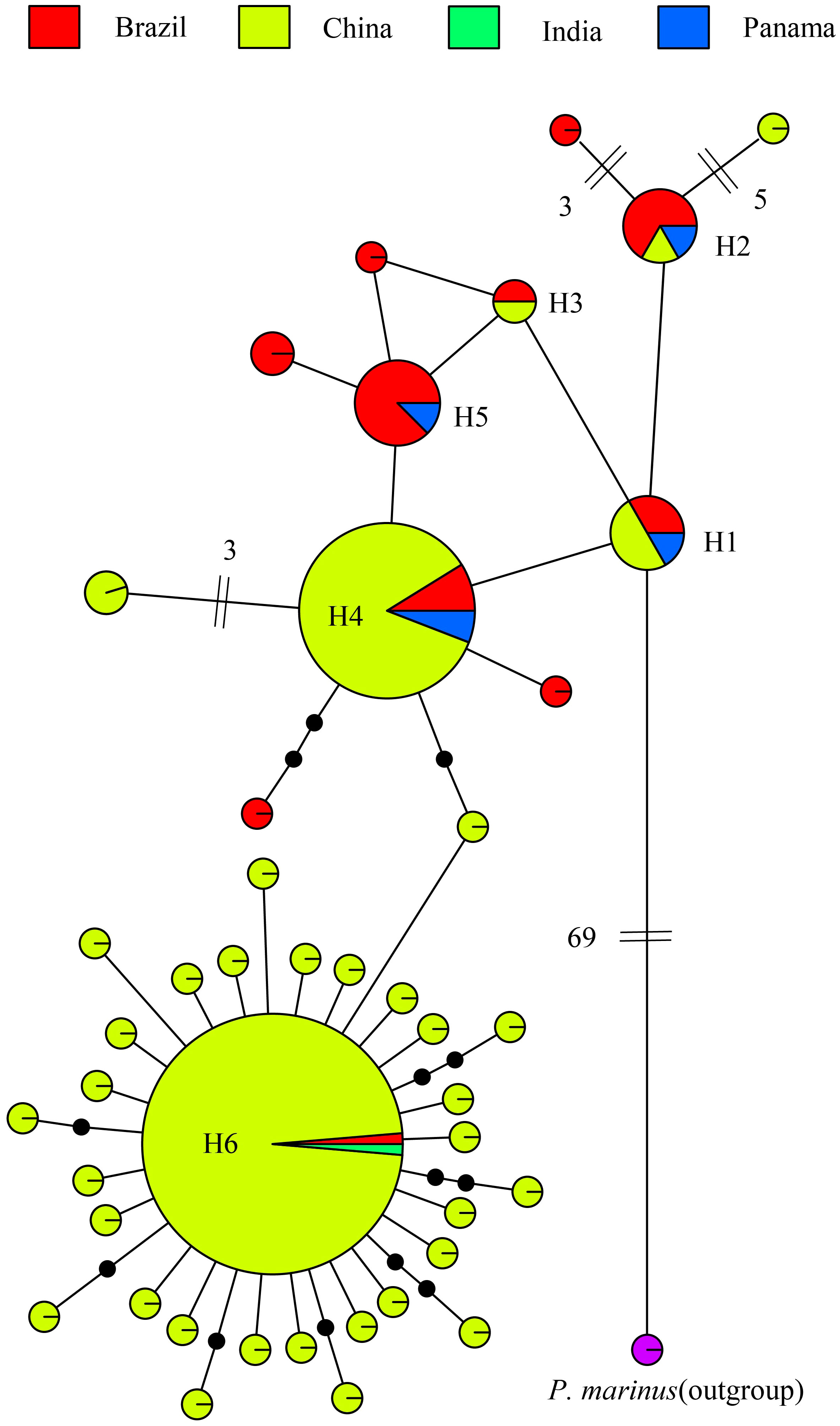
Figure 4 Haplotype networks of Perkinsus beihaiensis based on internal transcriber spacer sequence from China (this study) and additional sequences from GenBank that contained the sample location in their records. Colors indicate countries sampled. Neighboring haplotypes without double cross-bars indicate a single nucleotide mutation step or a gap. A nucleotide mutation step or gap of >1 between neighboring haplotypes is marked with double cross-bars, and the total numbers are indicated beside it. Black circles indicate inferred haplotypes not found in the sampled populations. Shared haplotypes are marked from H1 to H6 beside or inside the pie charts. The areas of the circles are proportional to the number of samples of each haplotype. Perkinsus marinus was used as the outgroup.
The haplotype networks of P. olseni showed that a total of 73 haplotypes were found from 11 countries (Figure 5). In this network, ten shared haplotypes were detected, including one haplotype (H10) shared by nine countries, two haplotypes (H3, H4) shared by eight countries, one haplotype (H9) shared by four countries, three haplotypes (H5, H6, H8) shared by three countries, and three haplotypes (H1, H2, H7) shared by two countries (Figure 5). Eight of the ten shared haplotypes were found in China. Sixty-seven percent of the haplotypes (49 of 73) was found in China, with 41 of the 49 haplotypes having been recovered only from China (Figure 5). All countries had at least one haplotype in common with at least one other country (Figure 5).
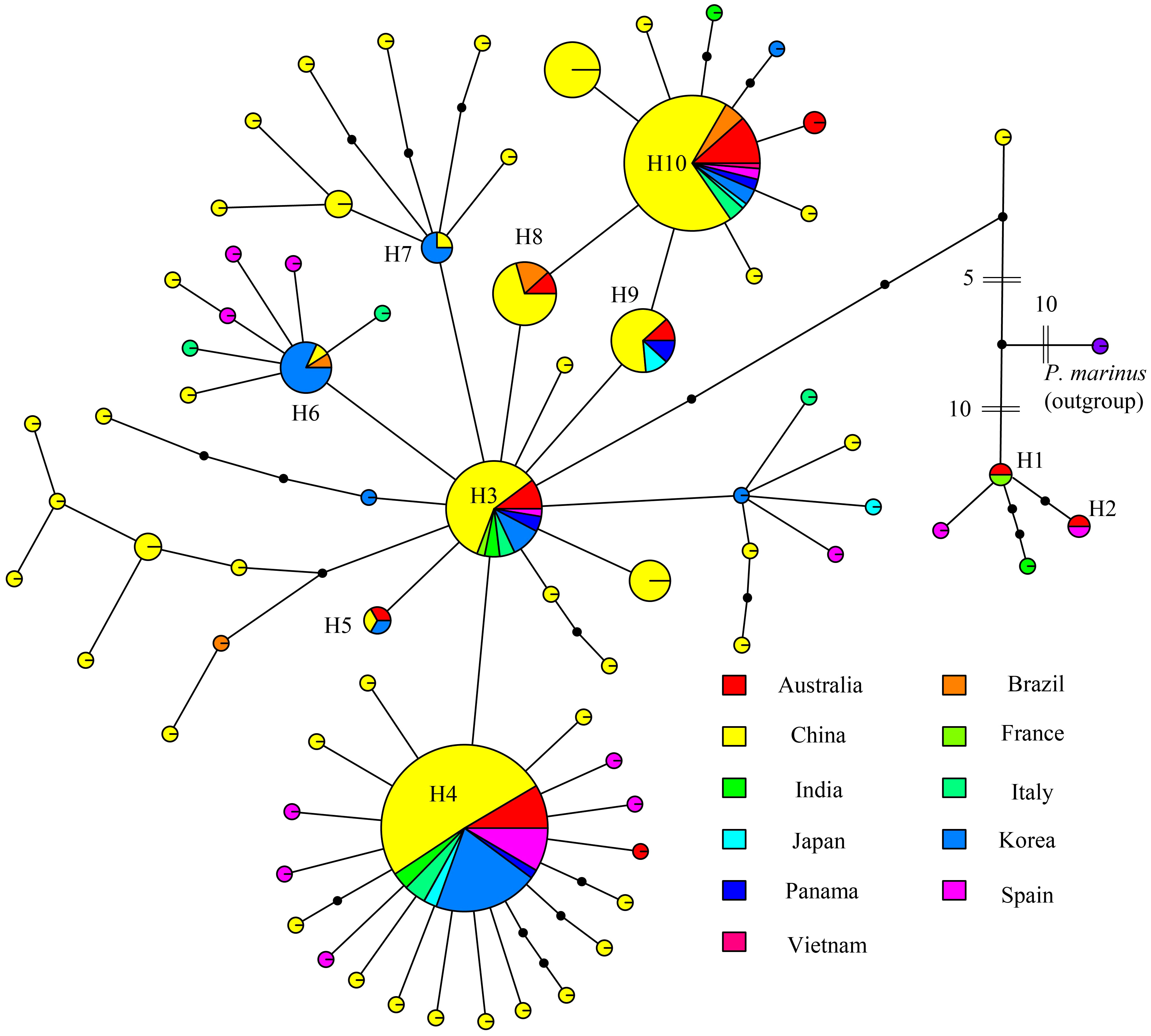
Figure 5 Haplotype networks of Perkinsus olseni based on internal transcriber spacer sequences. Colors indicate countries sampled. Neighboring haplotypes without double cross-bars indicate a single nucleotide mutation step or a gap. A nucleotide mutation step or gap of >1 between neighboring haplotypes is marked with double cross-bars, and the total numbers are indicated beside it. Black circles indicate inferred haplotypes not found in the sampled populations. Shared haplotypes are marked from H1 to H10 beside or inside the pie charts. The areas of the circles are proportional to the number of samples of each haplotype. Perkinsus marinus was used as the outgroup.
The P. chesapeaki global network analysis indicated that a total of 48 haplotypes were found from seven countries (Figure 6). In this network, three shared haplotypes were detected, including one haplotype (H1) shared by four countries (USA, Australia, France, China), one haplotype (H2) shared by three countries, and one haplotype (H3) shared by two countries (Figure 6). Two of three shared haplotypes were found in China. Fifteen percent of the haplotypes (7 of 48) was found in China, with five of the seven haplotypes having been recovered only from China (Figure 6).
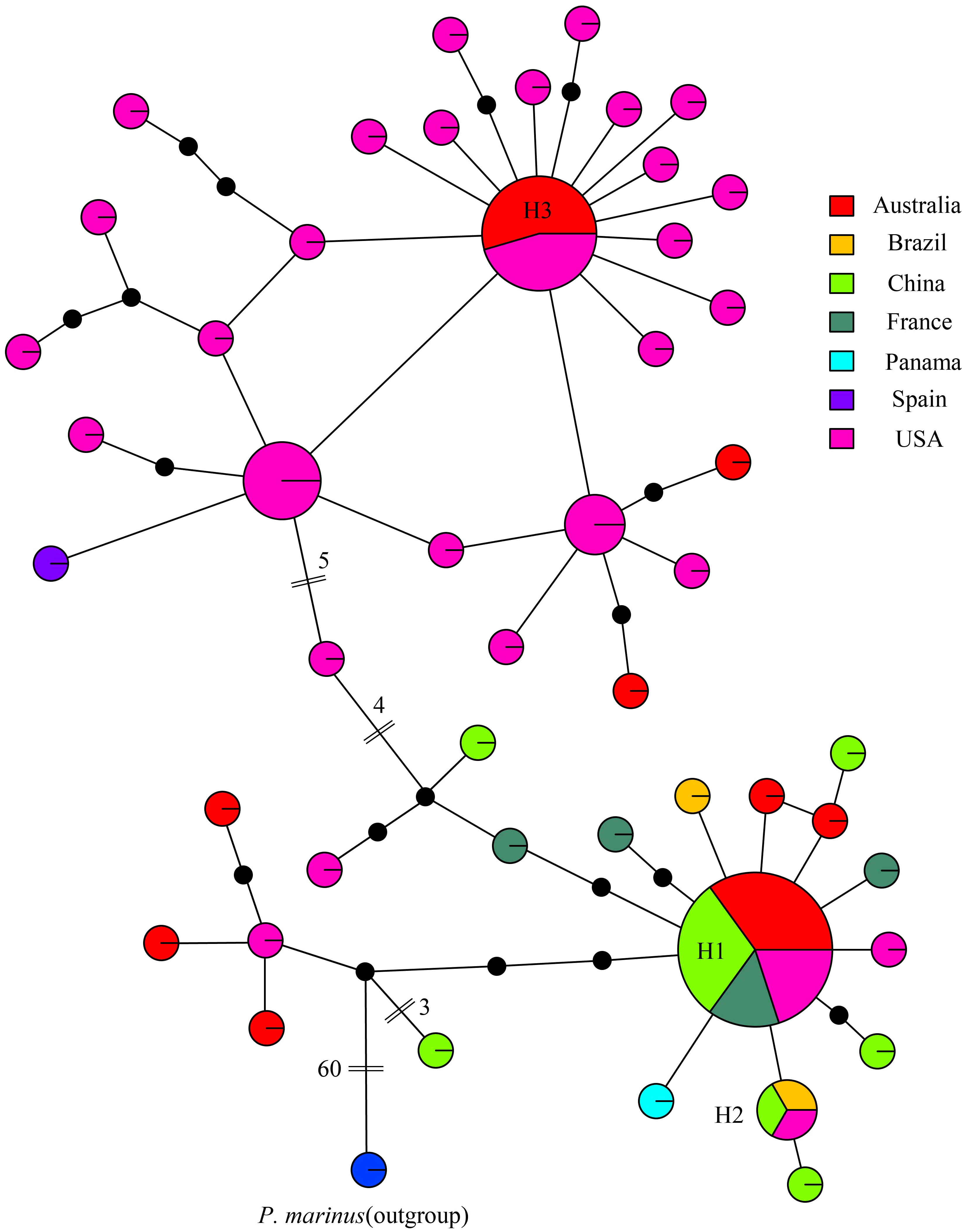
Figure 6 Haplotype networks of Perkinsus chesapeaki based on internal transcriber spacer sequence. Colors indicate countries sampled. Neighboring haplotypes without double cross-bars indicate a single nucleotide mutation step or a gap. A nucleotide mutation step or gap of >1 between neighboring haplotypes was marked with double cross-bars, and the total numbers are indicated beside it. Black circles indicate inferred haplotypes not found in the sampled populations. Shared haplotypes are marked from H1 to H3 beside or inside the pie charts. The areas of the circles are proportional to the number of samples of each haplotype. Perkinsus marinus was used as the outgroup.
Discussion
Previously, only two of seven known Perkinsus species (P. olseni and P. beihaiensis) had been reported in China, with P. beihaiensis as a new species first found in south China (Moss et al., 2008; Wu et al., 2011; Cui et al., 2018; Wu et al., 2019). Perkinsus chesapeaki, which was once a destructive pathogen causing decreased abundance and production of ecologically and economically important bivalve species in Chesapeake Bay, USA (McLaughlin et al., 2000), is first discovered carried by mollusks in coastal areas in China. Since its first report in North America, P. chesapeaki has been found invading Europe (Arzul et al., 2012), Australia (Dang et al., 2015), South America (Neto et al., 2016), and Asia (present study) in recent years. As commonly considered with other Perkinsus spp., this species was likely introduced into China through commercial transportation or introduction of their host molluscan species (Sheppard and Phillips, 2008; Pagenkopp Lohan et al., 2016). In China, three molluscan species—S. subcrenata, M. lyrata, and S. constricta—carried P. chesapeaki. Perkinsus chesapeaki was likely introduced into China through the commercial transportation of these molluscan species or Perkinsus-susceptible ballast water from abroad.
The higher PCR-prevalences of P. olseni and P. beihaiensis suggest that these Perkinsus species have long been present in the coastal waters of China. Previous studies suggested that P. olseni carrying only occurred in the northern part of the China Sea, such as the YBS (Wu et al., 2011) or the neighboring sea in South Korea (Yang et al., 2012), while P. beihaiensis carrying only occurred in the southern part of the China Sea (Moss et al., 2008; Wu et al., 2018). In this study, however, P. olseni and P. beihaiensis carrying was found in three different coastal regions, indicating that these species have spread almost completely along the coastal waters of China, probably because they have sufficient reservoir hosts, and form a mature transmission route among different regions. The lower PCR-prevalence of P. chesapeaki at three different coastal regions suggests that this species may have been introduced to China more recently and lacks sufficient reservoir hosts.
Although Perkinsus spp. were previously regarded to have low host specificity (Pagenkopp Lohan et al., 2016), an increasing number of studies have shown that Perkinsus spp. have a tendency to infect the clam R. philippinarum and the oyster C. hongkongensis, with these two hosts exhibiting relatively higher Perkinsus species prevalence and abundance (Moss et al., 2008; Choi and Park, 2010; Yang et al., 2012; Wu et al., 2018; Yang et al., 2022). In fact, Perkinsus species may be less host specific, but the wide culture range, high culture density, and frequent commercial trade of these two hosts may be the main factors increasing the likelihood of Perkinsus spp. infection. For example, R. philippinarum was one of the most widely cultivated molluscan species on the mudflats along the coast of China, including the SCS, ECS, and YBS. A large proportion of fresh R. philippinarum cultivated in the SCS (i.e., Beihai, Qinzhou, Zhanjiang) was commercially transported to the city along the ECS (i.e., Shanghai, Xiamen) or YBS (i.e., Qingdao, Tianjin) for human consumption, which facilitated the transmission of Perkinsus spp. among different marine regions (Yang, 2016). Perkinsus spp. may be dispersed to other molluscan species mainly by co-existing with Perkinsus-infected R. philippinarum and C. hongkongensis in the same sea regions (Wu et al., 2018; Yang et al., 2022).
In this study, the widespread distribution of the three Perkinsus spp. along the coast of China suggests that the main factors influencing the biogeography of Perkinsus spp. is the culture mode and anthropogenic transportation of molluscan hosts, but not the host traits or specificity because Perkinsus spp. have low host specificity (Dungan and Reece, 2020). The movement of mollusks at different growth stages among different coastal waters is a routine operation in molluscan culture in China. For example, most of the spats of the oyster C. angulata were hatched in Zhangzhou, Fujian Province (belonging to the ECS), but after approximately 2 months of culture, the spats were transported to coastal waters in Guangdong and Guangxi Province (belonging to the SCS) for further growth (Li et al., 2017). The long-distance transportation of commercial mollusks and broodstock also occurs regularly in China. The transportation of infected mollusks would thus contribute to the long-distance transmission of Perkinsus spp. in China. This movement may be the main transmission route for Perkinsus species across different coastal waters. Therefore, the detection and quarantine inspection of Perkinsus spp. during molluscan transportation are imperative for preventing the transmission and dispersal of Perkinsus spp. and containing outbreaks of perkinsosis in molluscan aquaculture (Cui et al., 2018).
Our results from the global haplotypes networks demonstrate that P. olseni, P. beihaiensis, and P. chesapeaki are three cosmopolitan parasite species, given that many shared haplotypes of these parasites were detected from different countries. We found that China had the greatest haplotype diversity of P. beihaiensis (86%) and P. olseni (67%) in the world, which suggests that these two species may originate from China, and have been widely transmitted and dispersed among molluscan species along the coast of China. Recent studies have demonstrated the higher tendency of Perkinsus infection with broader geographic range, lower prevalence, more diversified molluscan hosts, and more diversified Perkinsus haplotypes (Pagenkopp Lohan et al., 2016; Pagenkopp Lohan et al., 2018; Luz et al., 2018; Wu et al., 2018; Itoh et al., 2019; Luz Cunha et al., 2019). In the 21st century, molluscan mass mortality events caused by Perkinsus infection seldom occurred anywhere in the world. In the coastal waters of China, our team has been consistently monitoring Perkinsus infection variation in mollusks over the past decade (Cui et al., 2018; Wu et al., 2018; Wu et al., 2019; Yang et al., 2022), but we have not found any mass mortality of mollusks related to Perkinsus. Similar to our previous study, we found that Perkinsus infection in mollusks was characterized by no obvious gross signs, medium or low prevalence, low host specificity (Wu et al., 2018; Yang et al., 2022), and low abundance (Cui et al., 2018). We hypothesize that susceptible molluscan hosts (i.e., R. philippinarum) have improved the immunity and tolerance to Perkinsus infection after an extended period of competition and adaptation, thus lowering the prevalence or abundance of Perkinsus spp. and decreasing the chance of mass mortality. In response, Perkinsus spp. would target some other new molluscan species to maintain its population through continued survival and reproduction. The successful colonization of new mollusks not only contributes to the transmission and dispersion of Perkinsus spp., but also promotes the evolution of Perkinsus spp., thus increasing their genetic diversity. New molluscan hosts may also burden a large proportion of Perkinsus spp. that infected susceptible molluscan hosts, thus diluting the abundance of Perkinsus spp. in susceptible molluscan hosts and lowering the incidence of perkinsosis.
Conclusion
Our study reports, for the first time, the presence of P. chesapeaki along the coastal waters of China. Three cosmopolitan parasite species—P. olseni, P. beihaiensis, and P. chesapeaki—can be detected in most molluscan species, suggesting that they are widespread along the coastal waters of China. Perkinsis olseni is prominent in the YBS and ECS, while P. beihaiensis is prominent in the SCS. Most molluscan species carried Perkinsus spp. with medium or low levels of PCR-prevalence (<30%). Three Perkinsus spp. possess high levels of ITS haplotypes, some of which are shared among many countries. The main factors shaping Perkinsus species biogeography are culture mode and anthropogenic transportation of molluscan species, but not the host traits or specificity. The far higher PCR-prevalence of Perkinsus spp. in R. philippinarum and C. hongkongensis suggests that Perkinsus spp. may be transmitted and dispersed to other molluscan species through the transportation of Perkinsus-carried R. philippinarum and C. hongkongensis species. Perkinsus carrying tended to be generally linked with a broader geographic range, lower prevalence, more diversified molluscan hosts, and more diversified Perkinsus haplotypes.
Data availability statement
The datasets presented in this study can be found in online repositories. The names of the repository/repositories and accession number(s) can be found below: https://www.ncbi.nlm.nih.gov/- accession numbers MT908881 – MT908909.
Ethics statement
The animal study was reviewed and approved by South China Sea Fisheries Research Institute Academic Committee.
Author contributions
LY: Conceptualization, Methodology, Formal analysis, Investigation, Writing - original draft, Writing - review and editing, Funding acquisition, Project administration. LW: Investigation, Writing - original draft, Writing - review and editing. JL: Resources, Software, Validation. TY: Investigation, Validation, Visualization. JW: Investigation, Validation, Writing - original draft. SS: Investigation, Writing - original draft. GY: Writing - review and editing. WZ: Investigation, Funding acquisition. All authors contributed to the article and approved the submitted version.
Funding
This work was granted by the earmarked fund for CARS-49, the Shellfish and Large Algae Industry Innovation Team Project of Guangdong Province (2022KJ146), the Central Public-interest Scientific Institution Basal Research Fund, CAFS (2020TD42), the National Key R&D Program of China (2019YFD0900905), the Professorial and Doctoral Scientific Research Foundation of Huizhou University (2020JB0650), and the Financial Fund of Ministry of Agriculture and Rural affairs of China(NHYYSWZZZYKZX2020).
Acknowledgments
We thank Liwen Bianji (Edanz) (www.liwenbianji.cn/) for editing the English text of a draft of this manuscript.
Conflict of interest
The authors declare that the research was conducted in the absence of any commercial or financial relationships that could be construed as a potential conflict of interest.
Publisher’s note
All claims expressed in this article are solely those of the authors and do not necessarily represent those of their affiliated organizations, or those of the publisher, the editors and the reviewers. Any product that may be evaluated in this article, or claim that may be made by its manufacturer, is not guaranteed or endorsed by the publisher.
References
Aktas C. (2020) Haplotypes: Manipulating DNA sequences and estimating unambiguous haplotype network with statistical parsimony. Available at: https://CRAN.R-project.org/package=haplotypes.
Arzul I., Chollet B., Michel J., Robert M., Garcia C., Joly J. P., et al. (2012). One Perkinsus species may hide another: characterization of Perkinsus species present in clam production areas of France. Parasitology 139, 1757–1771. doi: 10.1017/S0031182012001047
Brousseau D. J., Guedes J. C., Lakatos C. A., Lecleir G. R., Pinsonneault R. L. (1998). A comprehensive survey of long island sound oysters for the presence of the parasite, Perkinsus marinus. J. Shellfish Res. 17 (1), 255–258.
Bureau of Fisheries of the China’s Ministry of Agriculture and Rural Affairs (2020a). China Fishery statistical yearbook (Beijing: Chinese Agricultural Press), 17, 23, 27.
Bureau of Fisheries of the China’s Ministry of Agriculture and Rural Affairs (2020b). 2020 aquatic animal health in China (Beijing: Chinese Agricultural Press), 3.
Casas S. M., Villalba A., Reece K. S. (2002). Study of perkinsosis in the carpet shell clam Tapes decussatus in Galicia (NW spain). i. identification of the aetiological agent and in vitro modulation of zoosporulation by temperature and salinity. Dis. Aquat. Org. 50, 51–65. doi: 10.3354/dao050051
Choi K. S., Park K. I. (2010). “Review on the protozoan parasite perkinsus olseni (Lester and Davis 1981) infection in Asian waters,” in Coastal environmental and ecosystem issues of the East China Sea. Eds. Ishimatsu E. A., Lie H. A. (Tokyo: Terra Scientific Publishing Company), 269–281.
Cui Y. Y., Ye L. T., Wu L., Wang J. Y. (2018). Seasonal occurrence of perkinsus spp. and tissue distribution of P. olseni in clam (Soletellina acuta) from coastal waters of wuchuan county, southern China. Aquaculture 492, 300–305. doi: 10.1016/j.aquaculture.2018.04.030
Dang C., Dungan C. F., Scott G. P., Reece K. S. (2015). Perkinsus sp infections and in vitro isolates from Anadara trapezia (mud arks) of Queensland, Australia. Dis. Aquat. Org. 113, 51–58. doi: 10.3354/dao02816
Dungan C. F., Reece K. S. (2020). “Chapter: 5.2.1 perkinsus spp. infections of marine molluscs,” in FHS blue book: Suggested procedures for the detection and identification of certain finfish and shellfish pathogens (Bethesda, Maryland: AFS-FHS (American Fisheries Society-Fish Health Section), 1–25.
FAO (2020). “Fishery and aquaculture statistics 2018,” in FAO yearbook (Rome: FAO). doi: 10.4060/cb1213t
Hall T. A. (1999). BioEdit: a user-friendly biological sequence alignment editor and analysis program for windows 95/98/NT. Nucleic Acids Symp. Ser. 41, 95–98.
Itoh N., Komatsu Y., Maeda K., Hirase S., Yoshinaga T. (2019). First discovery of Perkinsus beihaiensis in Mediterranean mussels (Mytilus galloprovincialis) in Tokyo bay, Japan. J. Invertebr. Pathol. 166, 107226. doi: 10.1016/j.jip.2019.107226
Krasnov B. R., Shenbrot G. I., Khokhlova I. S., Mouillot D., Poulin R. (2008). Latitudinal gradients in niche breadth: empirical evidence from haematophagous ectoparasites. J. Biogeogr. 35, 592–601. doi: 10.1111/j.1365-2699.2007.01800.x
Li H. S., Li J. M., Qin X. M., Zeng Z. N., Lin Z. S., Li Q. Z. (2017). The status, problems, and countermeasure of oyster industry in China-based on the an empirical analyses of Shandong fujian and guangdong guangxi provinces. Mar. Sci. 41, 125–129. doi: 10.11759//hykx20170713001
Luz M. S. A., Carvalho F. S., Oliveira H. C., Boehs G. (2018). Perkinsus beihaiensis (Perkinsozoa) in oysters of bahia state, Brazil. Braz. J. Biol. 78, 289–295. doi: 10.1590/1519-6984.07016
Luz Cunha A. C., Pontinha V., de Castro M. A. M., Sühnel S., Medeiros S. C., Moura da Luz Â.M., et al. (2019). Two epizootic perkinsus spp. events in commercial oyster farms at Santa catarina, Brazil. J. Fish Dis. 42, 455–463. doi: 10.1111/jfd.12958
Marquis N. D., Bishop T. J., Record N. R., Countway P. D., Fernandez Robledo J. A. (2020). A qPCR-based survey of Haplosporidium nelsoni and perkinsus spp. in the eastern oyster, Crassostrea virginica in Maine, USA. Pathogens 9 (4), 256. doi: 10.3390/pathogens9040256
McLaughlin S. M., Tall B. D., Shaheen A., Elsayed E. E., Faisal M. (2000). Zoosporulation of a new Perkinsus species isolated from the gills of the softshell clam Mya arenaria. Parasite 7, 115–122. doi: 10.1051/parasite/2000072115
Morand S. (2015). (macro-) evolutionary ecology of parasite diversity: from determinants of parasite species richness to host diversification. Int. J. Parasitol. Parasites Wildl. 4, 80–87. doi: 10.1016/j.ijppaw.2015.01.001
Moss J. A., Xiao J., Dungan C. F., Reece K. S. (2008). Description of Perkinsus beihaiensis n. sp., a new perkinsus sp. parasite in oysters of southern China. J. Eukaryot. Microbiol. 55, 117–130. doi: 10.1111/j.1550-7408.2008.00314.x
Neto M. P. D., Gestiera T. C., Sabry R. C., Fiejó R. G., Forte J. M., Boehs G., et al. (2016). First record of Perkinsus chesapeaki infecting Crassostrea rhizophorae in south America. J. Invertebr. Pathol. 141, 53–56. doi: 10.1016/j.jip.2016.10.007
Pagenkopp Lohan K. M., Hill-Spanik K. M., Torchin M. E., Aguirre-Macedo L., Fleischer R. C., Ruiz G. M. (2016). Richness and distribution of tropical oyster parasites in two oceans. Parasitology 143 (9), 1119–1132. doi: 10.1017/S0031182015001900
Poulin R., Krasnov B. R., Mouillot D., Thieltges D. W. (2011). The comparative ecology and biogeography of parasites. Philos. Trans. R. Soc Lond. B Biol. Sci. 366, 2379–2390. doi: 10.1098/rstb.2011.0048
R Core Team (2020). “R: A language and environment for statistical computing,” in R foundation for statistical computing (Vienna, Austria).
Shamal P., Zacharia P. U., Binesh C. P., Pranav P., Suja G., Asokan P. K., et al. (2018). Perkinsus olseni in the short neck yellow clam, Paphia malabarica (Chemnitz 1782) from the southwest coast of India. J. Invertebr. Pathol. 159, 113–120. doi: 10.1016/j.jip.2018.10.001
Sheppard B. J., Phillips A. C. (2008). Perkinsus olseni detected in Vietnamese aquacultured reef clams Tridacna crocea imported to the USA, following a mortality event. Dis. Aquat. Org. 79, 229–235. doi: 10.3354/dao01888
Thompson J. D., Gibson T. J., Plewniak F., Jeanmougin F., Higgins D. G. (1997). The Clustal_X windows interface: flexible strategies for multiple sequence alignment aided by quality analysis tools. Nucleic Acids Res. 25, 4876–4882. doi: 10.1093/nar/25.24.4876
Torchin M. E., Miura O., Hechinger R. F. (2015). Parasite species richness and intensity of interspecific interactions increase with latitude in two wide-ranging hosts. Ecology 96, 3033. doi: 10.1890/15-0518.1
Villalba A., Reece K. S., Camino Ordás M., Casas S. M., Figueras A. (2004). Perkinsosis in molluscs: A review. Aquat. Living Resour. 17, 411–432. doi: 10.1051/alr:2004050
Wenseleers T., Vanderaa C. (2018). “Export: Streamlined export of graphs and data tables,” in R package version 0.2.2. Available at: https://CRAN.R-project.org/package=export.
Wu S., Wang C., Lin X., Wang Z., Li X., Liu J., et al. (2011). Infection prevalence and phylogenetic analysis of Perkinsus olseni in Ruditapes philippinarum from East China. Dis. Aquat. Org. 96, 55–60. doi: 10.3354/dao02353
Wu L., Ye L. T., Cui Y. Y., Yao T., Lu J., Luo B., et al. (2018). Species diversity and seasonal occurrence of Perkinsus spp. in shellfish along coastal area of guangxi. South China Fish. Sci. 14, 110–114. doi: 10.3969/j.issn.2095-0780.2018.06.014
Wu L., Ye L. T., Wang Z. R., Cui Y. Y., Wang J. Y. (2019). Utilization of recombinase polymerase amplifcation combined with a lateral flow strip for detection of Perkinsus beihaiensis in the oyster Crassostrea hongkongensis. Parasite. Vector 12, 36. doi: 10.1186/s13071-019-3624-3
Yang X. (2016). Study on the change trend of world shellfish industry: based on the perspective of output. Chin. Fish. Eco. 34, 87–92.
Yang H. S., Park K. I., Donaghy L., Adhya M., Choi K. S. (2012). Temporal variation of Perkinsus olseni infection intensity in the Manila clam Ruditapes philippinarum in gomso bay, off the west coast of Korea. J.Shellfish Res. 31, 685–690. doi: 10.2983/035.031.0312
Keywords: Perkinsus spp. distribution in China Perkinsus, mollusks, diversity, distribution, Perkinsus chesapeaki, Chinese coast
Citation: Ye L, Wu L, Lu J, Yao T, Wang J, Shi S, Yu G and Zhao W (2022) Diversity and distribution of Perkinsus spp. along the coast of China: Implications for widespread transmission of Perkinsus spp. in mollusks. Front. Mar. Sci. 9:989261. doi: 10.3389/fmars.2022.989261
Received: 08 July 2022; Accepted: 28 September 2022;
Published: 13 October 2022.
Edited by:
Xuan Dong, Yellow Sea Fisheries Research Institute (CAFS), ChinaReviewed by:
Lusheng Xin, Yellow Sea Fisheries Research Institute (CAFS), ChinaHongbo Jiang, Shenyang Agricultural University, China
Copyright © 2022 Ye, Wu, Lu, Yao, Wang, Shi, Yu and Zhao. This is an open-access article distributed under the terms of the Creative Commons Attribution License (CC BY). The use, distribution or reproduction in other forums is permitted, provided the original author(s) and the copyright owner(s) are credited and that the original publication in this journal is cited, in accordance with accepted academic practice. No use, distribution or reproduction is permitted which does not comply with these terms.
*Correspondence: Lingtong Ye, bGluZ3RvbmcyNzUzQDEyNi5jb20=
 Lingtong Ye
Lingtong Ye Lin Wu1,2
Lin Wu1,2 Jie Lu
Jie Lu Tuo Yao
Tuo Yao Jiangyong Wang
Jiangyong Wang Wang Zhao
Wang Zhao